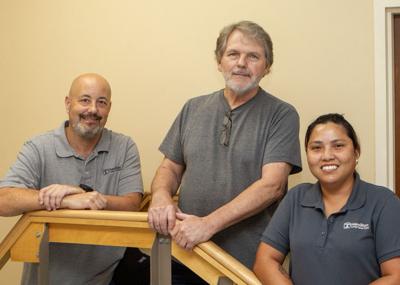Is your doctor and hospital prepared to deliver tPA in three minutes?
How fast do you have to be to get to 100% recovery? Is it 3 minutes like research in mice proves? Or don't you even fucking know about that research?
Electrical 'storms' and 'flash floods' drown the brain after a stroke
In this research in mice the needed time frame for tPA delivery is 3 minutes for full recovery.
The latest here:
Back in balance: Stroke recovery better for patients who get help fast
Troy Silvers, center, with Robby Mickelson, physical therapy assistant, and Abagail Roque, occupational therapist.
Troy Silvers can walk.
Not so long ago, that task — and many others once taken for granted — were nearly impossible. Following a stroke last summer, the Dalton resident entered Regency Park Health and Rehabilitation, part of Hamilton Health Care System, where he received intense therapy to help him recover from a partially paralyzed right side.
The type of stroke he experienced involving bleeding into the brain tissue is the second most common cause of stroke — between 15 and 30% of all strokes — and the most deadly. After being at Regency Park for several weeks, Silvers continued to make daily improvements toward recovery but has also made significant lifestyle changes, including incorporating exercise into his routine, monitoring his blood pressure, taking medication as prescribed and learning how to better manage stress.
“His physical limitations have not stopped him from joining his wife with daily walks and visits to their garden,” said Cherryl Berdos, rehabilitation director at Regency Park. “Recovering from a stroke can be a long and frustrating experience. It is normal to face difficulties along the way, but Mr. Troy’s dedication and willingness to work toward improvement helped him a lot.”
When he entered Regency Park, Silvers struggled to stand, walk, dress, eat and perform other daily tasks without assistance. Because his body was working so hard to compensate for the impairments, once-simple tasks became an exercise in frustration, and fatigue was a constant companion.
Berdos said he was often tempted to use only his unaffected side to improve efficiency.(But didn't his competent? doctor tell him of the research on using the good side recovers the bad side? NO! So not a competent doctor?
Exercising the good side to recover the 'bad' side. December 2012)
At first, he needed a walker to get around, plus two individuals to ensure safety. One would hold onto him while another followed with a wheelchair.
Now he can walk, climb stairs, bathe, dress and eat all on his own, and he continues to make daily efforts toward regaining more function. Silvers said he especially wants to thank Robby Mickelson and Abagail Roque who provided his physical and occupational therapy and worked with his entire treatment team.
When Silvers started rehab, he felt “100%” optimistic about his outcomes and was determined to get better every day. Today, he advises anyone going through a similar situation to “take care of your health, exercise (and) eat healthy.” Berdos said Silvers has also become an encouragement for other patients.
All Regency Park patients receive intensive rehab aligned with their level of healing and as determined by their physician.
“We create a personalized care plan, emphasizing your quality of life, dignity and comfort, which will help you reach your goals or help you manage an ongoing illness, chronic medical condition or disability,” said Berdos.
Act FAST (for face, arms, speech, time)
Time is of the essence when someone is experiencing stroke symptoms. If you or someone you know is experiencing face drooping, arm weakness or speech difficulty, call 911 immediately. By the time the ambulance reaches the emergency department, the responders will have started an IV and notified the medical facility that they are on the way with a possible stroke patient.

No comments:
Post a Comment